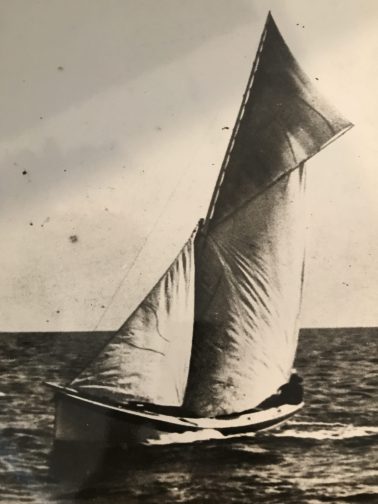
Shad boat flying its goose wing on Albemarle Sound ca. 1900. Photo by Ralph Munroe. Courtesy, State Archives of North Carolina
David Cecelski kicks off his series, “The Story of Shad Boats” with this introduction.
Today (April 27) I’m excited to start a special series called “The Story of Shad Boats.” Over a dozen posts, I’ll be exploring the origins, construction and history of those legendary traditional workboats that graced the waters of the North Carolina coast in the late 19th and early 20th centuries.
Throughout this series, my guide will be a remarkable body of oral history interviews, naval architects’ drawings, historical photographs and archival documents shared with me by the country’s leading authorities on shad boats and their history, Earl Willis Jr. and Mike Alford.
Over the last 40 years, Earl and Mike have documented the history of shad boats with a rigor, dedication and passion that I find exemplary and inspiring.
To my way of thinking, their work on shad boats has been one of the most important research projects on North Carolina’s maritime past in my lifetime.
So I want to start this special series by talking a little bit about Mike and Earl and their remarkable odyssey to document the story of the shad boat — the boat that, largely due to their efforts, the North Carolina General Assembly made the official “state boat” in 1987.
On Roanoke Island’s Shores
Now a retired high school teacher, Earl is a son of Wanchese, a village on the southern end of Roanoke Island, between the mainland of Dare County and the Outer Banks.

Earl Willis Jr. at his home in Edenton. Courtesy, Earl Willis Jr.
In the late 1870s, the first shad boat was built on Roanoke Island. For the next half century, the island remained the place where shad boats were most often built and used.
As we’ll see in more detail in the fifth part of this series, the large majority of boatyards that turned out shad boats were located either on Roanoke Island or within 20 miles of its shores.
When Earl was growing up in Wanchese, the age of the shad boat was long over. Yet his neighbors and relatives still talked about the shad boats of their youths with a kind of reverence that captivated him and made him want to know more about them.
Beginning in the 1970s, while he was still teaching, Earl began documenting the history of those unique workboats and their builders. He collected stories, visited with old shad boatbuilders, studied surviving shad boats and gathered many different kinds of documents that cast light on their history.
I find Earl’s interviews with the last surviving shad boat builders especially priceless. When he did his first interviews, the oldest people he visited could still recall boats and builders from the 1880s and ’90s.
That generation has passed now and we would have very few firsthand recollections of the shad boat’s heyday if it weren’t for Earl’s interviews, which he mostly did on his own but sometimes in the company of Mike, too.
Earl and Uncle Joe

Earl’s uncle Joe Meekins (1892-1997) in his shad boat Foul Play, built by George Washington Creef. Meekins restored the boat and added the canopy to use it as a pleasure boat. Courtesy, Earl Willis, Jr.
I can’t say enough about the importance of Earl Willis Jr.’s interviews with the last generation of shad boat builders and others who remembered those builders and their boats.
Between 1976 and 1986, Earl interviewed a total of 30 different builders, their family members and other people with firsthand knowledge of the shad boat’s history.
They included Moses Basnight, Capt. Wayland Baum, Ethel Midyette Carawan, H. A. Creef, Arnold Daniels, George Daniels, Edward Davis, Evelyn Davis, Newton Davis, Vernon Davis, Worden Dough, Wynne Dough, Floyd M. Gard, Vernon Gaskill, Max Guthrie, John Herbert, Joe Meekins, Ralph Meekins, P.D. Midgett, Gus Montague, Willie Rogers, Ira Spencer, Elijah Tate, Earl Tillett, Leland Tillett, Marshall Tillett, Sallye Baum Tillett, Hal Ward, Florine Tillett Williams and Edmond Wright.
Earl visited some of those individuals repeatedly. As his own knowledge of shad boats deepened, he returned to them repeatedly to ask more detailed and complex questions.
For instance, according to research notes that he and Mike shared with me, Earl talked 11 times with former shad boatbuilder Worden Dough on Roanoke Island.
He discussed shad boats with another veteran builder, Vernon Gaskill, on nine different occasions.
Earl’s uncle, Joe Meekins, was his most devoted informant. Born in Wanchese in 1892, Mr. Meekins started building boats with his father at the Wanchese Boat Shop and Railways in 1908. He worked on boats and built boats and ships for much of his life, even purchasing and restoring a shad boat when he was already 88 years old.
According to Earl’s notes, he and his uncle discussed the fine points of shad boat design and construction at least 22 times between 1981 and 1986.
Earl’s notes from those conversations alone would make for a remarkable textbook on shad boats and their history.
Mr. Meekins passed away in 1997, at the age of 105.
From State Ferries to Wooden Boats
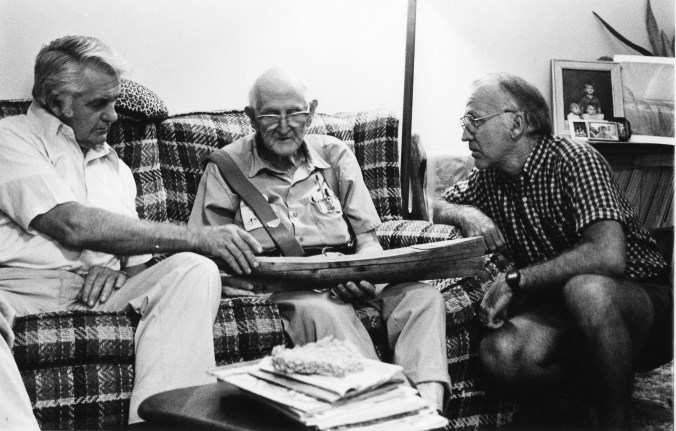
Mike Alford talking with shad boat builder Worden Dough (center) and H. A. Creef, Jr. (left), Manteo, N.C., circa 1980. Creef was the great-grandson of George Washington Creef. Photo by Earl Willis, Jr. Courtesy, Mike Alford
Mike Alford is another lifelong small-boat enthusiast. Originally from the Low Country of South Carolina, Mike was trained as a nautical architect.
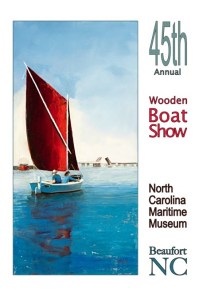
Poster for the N.C. Maritime Museum’s 45th annual Wooden Boat Show last year.
While working at the State of North Carolina’s ferry division, he designed the Governor Hyde, the largest state ferry at that time and one that I took many a time between Ocracoke Island and Cedar Island.
Mike later became the first curator of traditional watercraft at the North Carolina Maritime Museum in Beaufort, North Carolina. Among his many other accomplishments there, he co-founded the museum’s Wooden Boat Show, now in its 45th year.
As soon as Mike came to the museum in 1975, he began the first comprehensive survey of the state’s traditional workboat types and their history.
He visited old boatbuilders and learned from them. He studied historical accounts and visited museum collections.
He also analyzed the relics of historically significant boats that he and others found throughout the North Carolina coast.
Earl and Mike discovered their mutual passion for shad boats in 1981. If I may borrow a line from “Casablanca,” it was “the beginning of a beautiful relationship.”
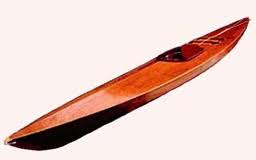
Mike has also designed smaller watercraft, including this lovely 15′ sea kayak, Tursiops. The plans are available from Wooden Boat magazine.
At that time, they began a remarkable collaboration that continues to this day, when both men are a tiny bit less spry than they were when they first began their shad boat research.
Throughout this series, my posts will draw from Mike and Earl’s published works, research notes, boat drawings, photograph files and other collections which they graciously shared with me.
I’ll also use the notes that I took when I joined the two of them on a trip to Roanoke Island several years ago.
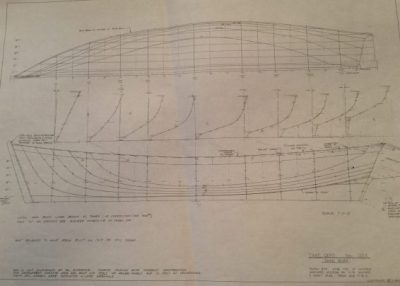
Delineation drawing of a shad boat. Taken off June 1981 at N.C. Maritime Museum by Mike Alford and Marty Blee. Drawn Aug. 1981 by Mike Alford.
A Door into Another Time and Place
I will present this series in the following 12 parts:
- Introduction
- Looking the Wind Square in the Eye
- What the Keel Tells Us
- A Grand Old Soul
- Shad Boat Country
- Earl Willis, Jr.’s Sketch of a Shad Boat
- Root Knees & Juniper Swamps
- Planking Up
- Spritsails & Goose Wings
- Proggin’
- Capt. Nal Midyette: The Shad Boat Builder of Engelhard
- The Last Shad Boats
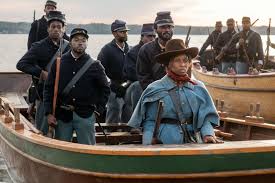
Mike Alford also designed the first and only replica of a periauger, one of the N.C.’s most important traditional workboats in the 18th and 19th centuries. The replica is usually docked at the Newbold-White House in Hertford. In the film “Harriet,” Harriet Tubman leads a Union regiment into battle in the periauger that he designed. Courtesy, Focus Features
At the end of the series, I will also examine the boat’s transition from sail to gasoline engines, its final days and its legacy in our maritime history.
So let’s begin. In my next post, I’ll move forward with a general overview of shad boats—what exactly is a shad boat? What was distinctive about them? And why are they still held in such high esteem?
In a way, the question is this: what is it about a small wooden boat that was only built in one tiny corner of the North Atlantic for barely half a century that continues to capture our imaginations?
Even in a 12-part series, I cannot tell the shad boat’s whole story.
But over the next couple weeks, I hope that I can at least convey a good general sense of what Earl and Mike have accomplished and what I have learned from them about these extraordinary watercraft.
By looking at shad boats closely and from many different angles, I hope we might also discover in them something of a portal into another time and place– a door, so to speak, into the largely forgotten coastal world in which the shad boat was created, built and used.
Read more
Coastal Review Online is featuring the work of historian David Cecelski, who writes about the history, culture and politics of the North Carolina coast. Cecelski shares on his website essays and lectures he has written about the state as well as brings readers along on his search for the lost stories of our coastal past in the museums, libraries and archives he visits in the U.S. and across the globe.
Like This Story?
It costs about $500 to produce this and all other stories on CRO. You can help pay some of the cost by sponsoring a day on CRO for as little as $100 or by donating any amount you're comfortable with. All sponsorships and donations are tax-deductible.
"story" - Google News
May 13, 2020 at 11:11AM
https://ift.tt/3bvleyq
The Story of Shad Boats - Coastal Review Online
"story" - Google News
https://ift.tt/2YrOfIK
https://ift.tt/2xwebYA
Bagikan Berita Ini














0 Response to "The Story of Shad Boats - Coastal Review Online"
Post a Comment